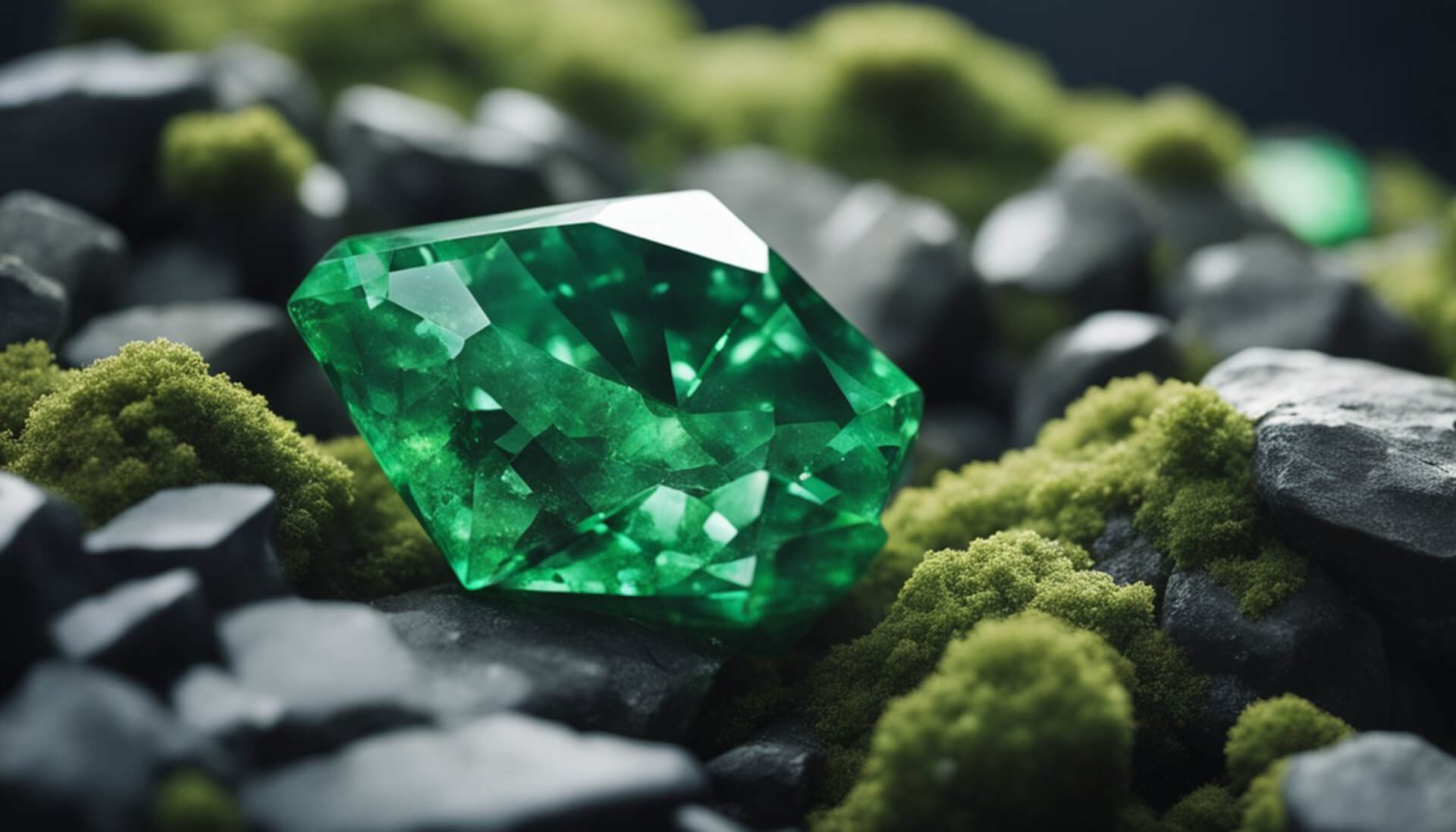Birthstones hold significance in various cultures. Each month is assigned a gemstone rich in history and meaning. The birthstone for May is the emerald, a gem prized for its vibrant green color and lustrous appeal. Considered a symbol of rebirth and growth, emeralds have been coveted for centuries and have accumulated a wealth of lore and tradition. Rich in history, the emerald has been adorned by royalty and celebrated in mythologies, asserting its place as a stone of great value and beauty.
Emeralds are known for their aesthetic charm and supposed healing properties. Wearing an emerald is believed to bring an individual wisdom, growth, and patience.
Geologically, emeralds are a variety of beryl and possess a distinct green color due to trace amounts of chromium and sometimes vanadium. Their unique properties and origins make emeralds both a cherished jewelry ornament and a scientific fascination subject.
Emeralds can be found in various regions worldwide, each source adding to the depth and uniqueness of the stone’s characteristics.
Historical Significance
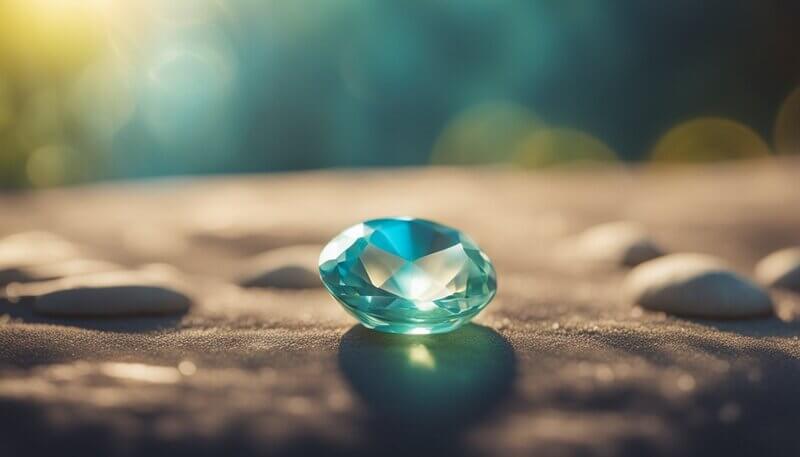
The emerald, revered across civilizations, has a storied past where it has consistently been embellished with deep meaning and value. Notably, its significance is rooted in ancient Egypt and Greece, which are influential cultures that greatly influenced this precious stone’s lore.
Ancient Connections
- Egypt: Emeralds have a profound lineage dating back to at least 330 BC in Egypt, with mines flourishing through the 1700s. Cleopatra, Egypt’s last Pharaoh, was famously enamored with emeralds, often incorporating them into her royal regalia to showcase her wealth and power.
- Greece: The ancient Greeks also highly regarded emeralds. The stone was synonymous with the goddess Venus, representing love and beauty.
They believed emeralds possessed the power to protect the wearer from deception and granted foresight, linking them intimately with wisdom and prophecy.
Historical Lore
- Lore: Emeralds are woven into a myriad of legends and myths. They were thought to calm storms, bestow riches and power, and even enable their wearers to see into the future. This belief in their mystical properties was not limited to one culture or era, pervading centuries of lore.
- Rich Associations: Throughout history, emeralds have been the choice of the wealthy and influential. Their deep green hue is often seen as a symbol of renewal and vitality, virtues that are consistently cherished in various folklores and by individuals who sought more than just physical beauty in their choice of gems.
Related: What is Taurus birthstone
Emerald Characteristics
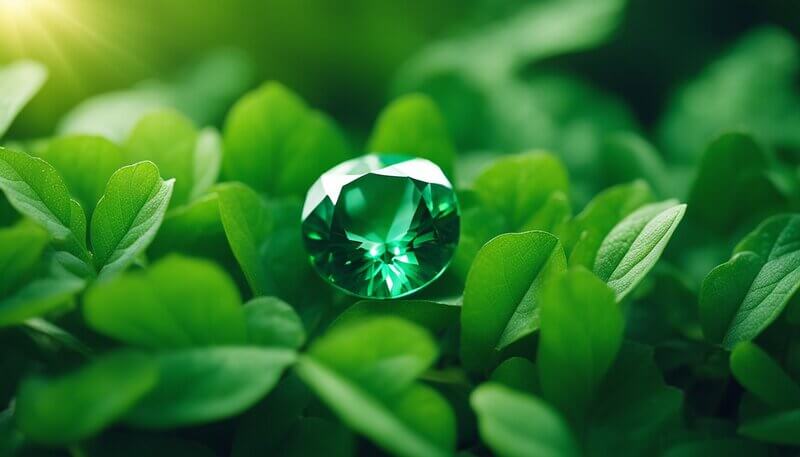
Emeralds stand out for their vibrant hues, transparency, and precise cuts, which showcase their beauty. Owing to their unique chemical composition, these gemstones reflect a spectrum of green color.
Color Variations
Emeralds are highly cherished for their green color, ranging from bluish-green to deep green. Chromium and sometimes vanadium contribute to the gemstone’s rich color.
The value of an emerald can significantly increase with the intensity and saturation of its green hue. Colorless areas are not typically found in emeralds, as color is the gemstone’s most defining characteristic.
Clarity and Cut
Emeralds’ clarity is notably marked by inclusions, which are tolerated more than in other gemstones due to their commonality.
These inclusions are often referred to as “jardin,” the French word for garden, because they can resemble plant foliage. A skilled cut can enhance the stone’s inherent luminosity and help mask the visibility of inclusions.
Preferred cuts for emeralds include the emerald cut, a rectangular shape with cut corners that amplifies the stone’s color and clarity while ensuring durability.
Chemical Composition
Emeralds are a variety of the mineral beryl, primarily comprised of beryllium aluminum silicate. The chromium content within the beryl structure is responsible for the green coloration, and occasionally vanadium may be present.
The unique interplay of elements gives each stone a distinct light absorption pattern, which defines the individual hue and saturation of the emerald.
Spiritual and Healing Properties
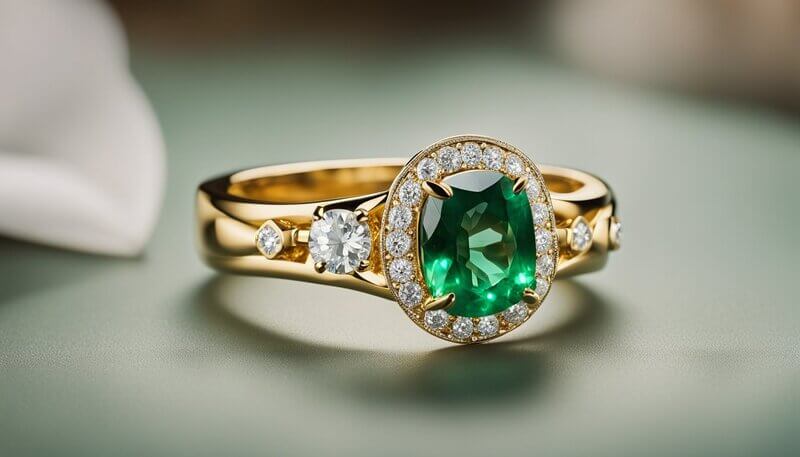
The May birthstone carries unique properties believed to enhance spiritual wellness and physical health. Its distinct characteristics resonate with notions of healing, love, and fertility.
Body and Mind
The Emerald, recognized as the May birthstone, is often associated with therapeutic effects on the body and the mind.
Featured Partner Offer
Historically, it is said to revitalize tired organs and boost mental acuity. Individuals turn to Emerald for its purported ability to soothe physical ailments while also providing mental clarity and emotional balance.
- Healing: It’s believed to promote health and physical vitality.
- Mind: Thought to aid concentration and rejuvenate one’s spirit.
Birthstone Benefits
Emeralds are gemstones linked to a myriad of benefits, often intertwining with aspects of love and passion.
As the May birthstone, it is also considered a symbol of fertility and abundance, which extends beyond reproduction to ideas involving creativity and wealth.
- Love: The stone is said to open the heart, attracting romantic love.
- Fertility and Creativity: Its symbolic connection to fertility is believed also to encompass creative ideas and endeavors.
- Passion: Believers in crystal healing may seek out Emerald to ignite or maintain passion, whether emotional or intellectual hunger.
Emerald Sources and Geology
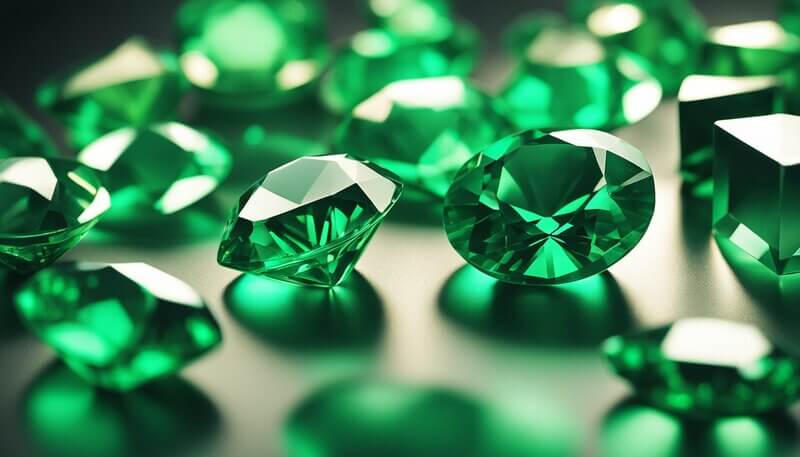
Emeralds, cherished for their vivid green hue, are a variety of beryl, a mineral that gains its color from traces of chromium and vanadium. Known to grace the collections of royalty and connoisseurs alike, these gemstones are found across specific regions around the globe, rooted deep in unique geological processes.
Primary Mining Locations
Emerald deposits are scattered across several continents, with each location’s geology contributing to the gemstone’s characteristics.
Brazil is notable for its extensive emerald mines, which produce stones in various green shades.
The rich emerald deposits of Zambia are renowned for their high-quality gems, which have a deep green color.
Colombia’s emerald mines are perhaps the most famous. They yield highly sought-after emeralds, often distinguished by their pure and intense green color with a slight bluish tint.
Though less prolific than the other regions, Afghanistan also supplies emeralds to the global market.
| Country | Notable Characteristics |
| Brazil | Wide range of green shades |
| Zambia | High-quality, deep green color |
| Colombia | Pure, intense green with a bluish tint |
| Afghanistan | Distinctive emeralds in the global market |
Formation Process
The formation of emerald is a rare occurrence, requiring precise geological conditions.
Emeralds form within metamorphic rocks, where beryl integrates with trace amounts of chromium and vanadium, imparting the iconic green coloration.
The necessary elements often come together at sites where tectonic activity provides the needed pressure and temperature. This transformative process occurs deep within the Earth’s crust, leading to the development of emerald crystals over millions of years.
| Geological Requirement | Contribution to Emerald Formation |
| Metamorphic Rocks | Provide the structure for beryl crystallization |
| Chromium & Vanadium | Impart the green color |
| Tectonic Activity | Offers pressure and temperature for growth |
Cultural and Symbolic Meanings
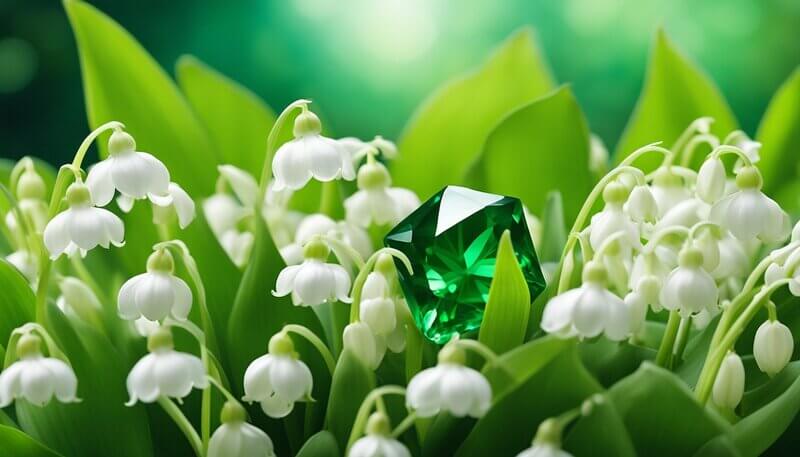
Emeralds, the birthstone of May, are rich with cultural significance and symbolic meanings that span various civilizations.
Mythology and Folklore
In mythology, emeralds were closely associated with Venus, the Roman goddess of love and beauty. The Greeks similarly linked the gemstone with Aphrodite.
The reverence for emeralds in these cultures highlights the stone’s embodiment of beauty and love.
Historical narratives across civilizations have chronicled emeralds as a symbol of royalty and wisdom. They were often worn by monarchs and spiritual leaders to represent their status and intellect.
Modern Associations
Today, emeralds carry the essence of rebirth and spring.
Its lush green color indicates the new growth in springtime, resonant with the theme of renewal.
Modern interpretations also hold emeralds to symbolize wisdom, seeking to instill a sense of foresight and enlightenment in those who wear it.
This gemstone is often gifted as a symbol of lasting love and a tribute to the timeless value of wisdom.
Emerald in Jewelry
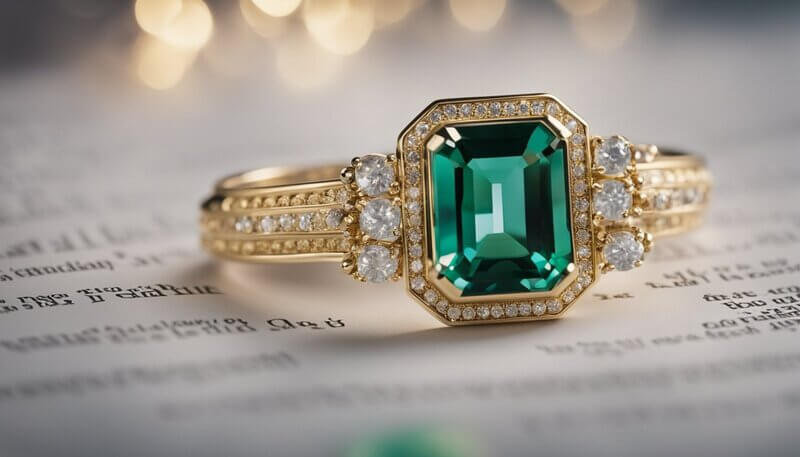
Emeralds have long been treasured for their stunning green hue and are frequently featured in various types of jewelry, including rings, earrings, necklaces, and bracelets.
Jewelers often incorporate emeralds in their designs as these gemstones offer an exquisite touch of elegance.
Popular Types
Rings: Emeralds are often set into rings as solitaires or accented by diamonds and other gemstones.
The cut of the emerald is crucial. Shapes like Emerald cut, Oval, and Pear are popular choices to showcase the gemstone’s clarity and color.
Earrings and Pendants: Due to their vivid color, emeralds make striking earrings whether as simple studs or elaborate drops. As pendants, they often hang from a delicate chain, providing a subtle yet sophisticated centerpiece.
Necklaces and Bracelets: Emeralds in necklaces range from single gemstone pendants to elaborate pieces featuring multiple stones. Likewise, bracelets can be tennis-style, encrusted with emeralds, or feature larger stones as focal points.
Tiaras: While less common, emeralds have been used historically in tiaras and crowns, symbolizing royalty and prestige.
Care and Maintenance
Regular Cleaning: Emerald jewelry should be gently cleaned with mild soap and warm water using a soft brush to remove any dirt buildup.
It’s crucial to avoid harsh chemicals, as they can damage the gemstone.
Storage: To prevent scratches, store emerald jewelry separately from other pieces. Wrapping them in a soft cloth or placing them in a fabric-lined jewelry box is advisable.
Professional Check-ups: It’s recommended that emerald jewelry be inspected by a professional jeweler occasionally for any necessary repairs. This is particularly important to check settings and clasps for wear.
Emerald Varieties and Related Gems
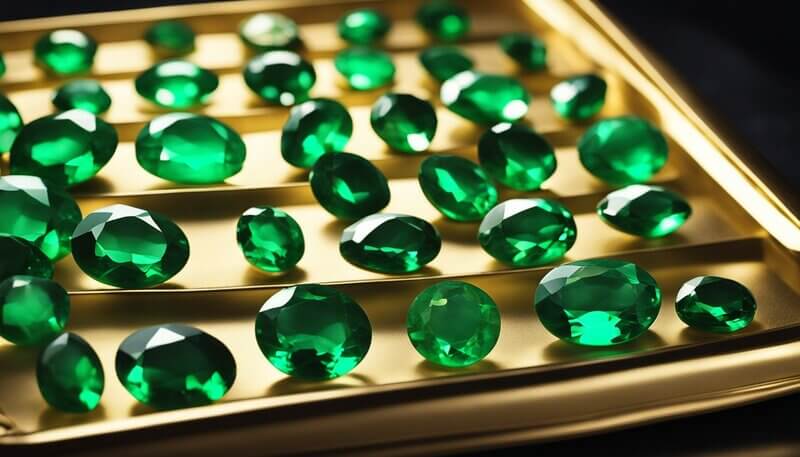
Emeralds, which belong to the beryl family of minerals, are prized for their rich green hue. They are often compared with other colored gemstones in color, hardness, and rarity.
Comparisons with Other Gemstones
Sapphire: While emeralds are defined by their green color, sapphires are typically associated with blue, though they can occur in various colors.
Emeralds are generally less hard than sapphires, registering 7.5-8 on the Mohs scale. In comparison, sapphires have a rating of 9.
Ruby: Known for their vibrant red color, rubies are a form of corundum like sapphires and are, therefore, harder than emeralds.
Both rubies and emeralds are considered precious gemstones and have a comparable appeal in jewelry.
Aquamarine: Sharing the same mineral family with emeralds, aquamarine exhibits a blue to blue-green color.
Although both are beryl, aquamarine typically lacks the inclusions found in emeralds, giving it a greater clarity.
Diamond: Diamonds are the hardest known natural material and are valued for their unmatched durability and brilliance.
However, emeralds’ distinctive green offers an appeal different from the colorless sparkle of diamonds.
Garnet: Garnets are commonly red but can also be found in various other colors, including green.
However, garnets’ green varieties—like tsavorite—do not have the same depth of color as emeralds.
Colors: In addition to green beryl (emerald), beryl comes in other colors, such as yellow (heliodor), blue (aquamarine), pink (morganite), and colorless (goshenite).
Each variety has its unique charm, with emerald being the most valued for its deep green shade.
Alexandrite: This gemstone is famed for its color change, appearing green in daylight and red in incandescent light.
Alexandrite is rarer than emerald and typically more expensive due to this unique optical property.
Tourmaline: Tourmaline can resemble emerald in its green form, known as verdelite or chrome tourmaline, but it is generally less valuable and lacks the signature emerald green color saturation.
Gemstones: While each gemstone possesses its unique beauty and physical properties, emeralds are distinct with their inclusions and fractures, known as “jardin,” which add to their character and uniqueness.
Buying Guide

When purchasing a birthstone for May, understanding quality factors and market variables ensures a sound investment in a timeless piece of jewelry.
Quality Assessment
Clarity and Cut: These are two fundamental aspects to consider.
Emeralds, the traditional birthstone for May, are graded on clarity, with inclusions often affecting this measure. Buyers should seek stones that balance clarity with character.
The stone’s cut is crucial, too, as it can enhance both the color and brilliance.
A well-executed cut will ensure the gemstone catches the light beautifully, creating a visually appealing effect.
| Feature | Description |
| Clarity | Look for minimal visible inclusions. The fewer, the better the clarity. |
| Cut | Choose cuts that enhance the stone’s natural beauty and maximize sparkle. |
Market Considerations
When assessing the market for gemstones, particularly emeralds, buyers should consider affordability and setting options, such as gold, which can complement the stone’s rich green hue.
Affordable Options: Sapphires in green can be a cost-effective alternative to emeralds.
While not the traditional birthstone for May, they offer similar beauty.
Metal Settings: Gold settings are classic and enhance the natural verdancy of emeralds.
The setting should secure the stone firmly while showcasing its beauty.
| Consideration | Tips |
| Affordability | Compare emeralds and alternative stones like green sapphires. |
| Metal Settings | Opt for stable settings like gold that highlight the gemstone’s color. |
Buyers should examine a range of rings to find a birthstone that aligns with their aesthetic preferences and budget. When available, remember to authenticate the stone’s quality through certificates.
Emerald Throughout the Zodiac
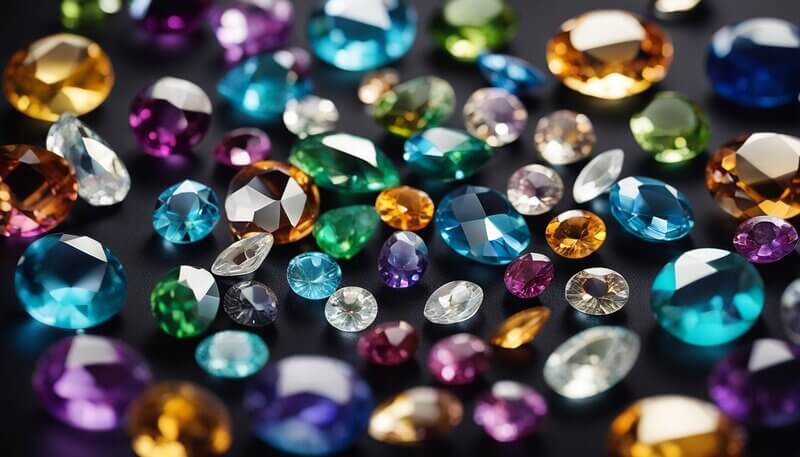
The emerald, the May birthstone, is particularly significant for those born under the zodiac signs of Taurus and Gemini. It is symbolic of the growth and renewal so often associated with spring.
Taurus and Gemini Relations
Emeralds resonate profoundly with Taurus individuals, born between April 20 and May 20.
This gemstone symbolizes the lushness of their season, reflecting Taureans’ appreciation for beauty and consistency. Its green hue is believed to bring them balance and encourage growth in various aspects of life, from personal to professional.
When considering Gemini, whose birth dates fall from May 21 to June 20, emeralds are thought to harness the energy of Mercury, the ruling planet for this sign.
Geminis might find that emeralds enhance their communication skills, which is fitting for their articulate and adaptable nature. The stone’s reputed properties of promoting foresight and wisdom may also help Geminis navigate their dual-sided personalities.
Famous Emerald Pieces
Emeralds have long been associated with royalty and have featured prominently throughout history. Some of the most famous emerald pieces are steeped in history and legend.
The Hooker Emerald Brooch: This exquisite piece, which is now part of the Smithsonian’s collection, features a 75.47-carat emerald.
It once belonged to Abdul Hamid II, Sultan of the Ottoman Empire, who wore it on his belt buckle.
Elizabeth Taylor’s Emerald Pendant: This is not only a piece of jewelry but a symbol of Hollywood glamour.
Richard Burton gave Taylor this stunning pendant, showcasing a large emerald of remarkable quality.
The Crown of the Andes: Believed to be made in the 17th century in Colombia, it is one of the most historic pieces containing emeralds.
Its splendid emeralds symbolize a time when the country was one of the largest producers of these gems.
The Devonshire Emerald: Held by the Duke of Devonshire’s collection, this 138.7-carat emerald is one of the largest uncut emeralds in the world.
Unlike many emeralds, it has not been faceted, retaining its natural hexagonal crystal form.
| Item | Description | Provenance |
| The Hooker Emerald Brooch | 75.47-carat emerald set in a brooch | Ottoman Empire, now in the Smithsonian |
| Elizabeth Taylor Pendant | Large, high-quality emerald | Gift from Richard Burton |
| The Crown of the Andes | Historic, emerald-encrusted crown | Made in Colombia, 17th century |
| The Devonshire Emerald | One of the largest uncut emeralds at 138.7 carats | Owned by the Duke of Devonshire |
Egypt’s Influence: While not a piece, the history of emeralds cannot overlook Egypt’s part. Cleopatra herself was famously enamored with emeralds. The ancient mines of Egypt served as a significant source of emeralds for a bygone era.
Conservation and Ethical Sourcing
The provenance of May’s birthstone, the emerald, is of considerable importance in the world of gemstones.
A deep understanding of conservation and ethical sourcing practices is critical in acquiring these gemstones. This is particularly true in Brazil and Zambia, where significant mining activities occur.
Ethical Sourcing Initiatives:
- Brazil and Zambia are committed to reducing the environmental impact of emerald mining.
- These initiatives include efforts to minimize landscape disruption and to maintain biodiversity.
- Community engagement and fair labor practices are also fundamental to ethical sourcing.
Mining Practices and Environmental Stewardship:
- Responsible mining practices aim to ensure that natural habitats are preserved and restored.
- Given the heavy usage in gemstone mining processes, water conservation is a priority.
- The use of non-toxic chemicals in the extraction of emeralds is an emerging standard.
Certifications and Compliance:
- International organizations offer certification programs to validate mines that adhere to strict ethical and conservation guidelines.
- Compliance with these standards helps consumers make informed decisions and supports ethical gemstone consumption.
The emerald market is responding to calls for conservation and ethical practices. It acknowledges the impact on both the environment and local communities involved in the mining of these precious gemstones.
With increasing consumer awareness, the industry is shifting towards a more responsible and sustainable future.
Frequently Asked Questions
This section addresses common inquiries about the birthstone for May, providing valuable insights for anyone interested in this gemstone.
1. What is the birthstone for May?
May’s birthstone is the emerald, a gemstone known for its vibrant green color and association with spring.
2. Can May’s birthstone be found in different colors?
While the traditional color for May’s birthstone is green, emeralds can come in various shades from light to deep rich green. The presence of chromium and vanadium gives emeralds their green color.
3. What is the significance of May’s birthstone?
Emeralds are often associated with love, rebirth, and renewal. Historically, they were believed to bestow foresight and good fortune upon the wearer.
4. Are there alternative gemstones associated with May?
Yes, alternative gemstones for May include agate, alexandrite, and chrysoprase, each with its unique beauty and properties.
5. How can I identify an authentic May birthstone?
Identifying an authentic May birthstone, such as an emerald, involves examining its color, cut, clarity, and inclusions. It is recommended to seek verification from a reputable jeweler or gemologist.
6. What jewelry options are popular for featuring May’s birthstone?
Popular jewelry options featuring May’s birthstone range from classic emerald rings and pendants to earrings and bracelets.
They are often set in both gold and silver to complement the stone’s rich green hue.

